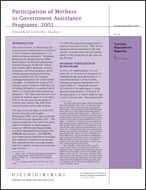Participation of Mothers in Government Assistance Programs: 2001
Participation of Mothers in Government Assistance Programs: 2001
Introduction
This report focuses on the fertility and socioeconomic characteristics of mothers in 2001 related to participation in six public assistance programs: Temporary Assistance for Needy Families (TANF); food stamps; the Special Supplemental Nutrition Program for Women, Infants, and Children (WIC); Medicaid; housing assistance; and other programs, which include general assistance and other types of welfare. It expands the scope of the previous report, based on 1996 data, by including information on mothers’ participation in housing and other assistance programs.1 The report also focuses more closely on mothers aged 15 to 44 with a birth in the last year, as the needs of mothers with infants may differ from those of mothers with older children.
The data come from Wave 2 of the 2001 Survey of Income and Program Participation (SIPP), which was conducted from June through September 2001. This report provides the first look at the participation of mothers in these programs since the 1996 Personal Responsibility and Work Opportunity Reconciliation Act (PRWORA) was enacted. The PRWORA gave states greater flexibility to formulate and implement initiatives to reduce welfare dependency and encourage employment for members of low-income families with children.2
The SIPP data represent program participation at one point in time. They do not represent annual caseloads or the total number of people who may have participated in these programs at any time during the year.3
_______________
1 Jane L. Dye, Fertility and Program Participation in the United States: 1996. Household Economic Studies, P70-82. U.S. Census Bureau: Washington, DC, 2002.
2 U.S. Congress, Public Law 104-193. H.R. 3734, 1996.
3 The data in this report were collected from June through September 2001 in the second wave (interview) of the 2001 Survey of Income and Program Participation. The population represented (the population universe) is the civilian noninstitutionalized population living in the United States. Differences may be noted between estimates of program participation shown in this report and estimates presented in reports from agencies that administer these programs. In addition to different universe definitions (this analysis includes only mothers 15 to 44 years old), the SIPP data are based on participation at one point in time rather than total participation in a calendar year. Administrative data may include people multiple times as they enroll, leave, and re-enroll in a program over the course of a year. In addition to these differences, reports of program participation may be affected by different names of programs in different states and by inaccuracies or omissions made by the household respondent for other members of the household in the survey.
Detailed Tables
Additional File Formats
Additional file formats can be accessed in our archives.
Source and Accuracy
Below is the Source and Accuracy information from the Survey of Income and Program Participation:
Wave 2
Others in Series
Publication
Families and Living Arrangements
Publication









